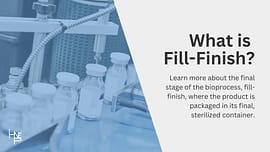What is a Single-use Assembly
Understanding the importance of single-use technology in the evolving biopharmaceutical industry.

Table of Contents
What is a Single-use assembly?
A single-use assembly is a solution developed for a bioprocess that is either custom designed, or provided off-the-shelf as a single-use flow path for a specific biopharmaceutical application.
Whether for initial drug discovery or large scale drug production, a unique assembly can be crafted for that specific application and in the necessary quantity. With an infinite number of component variations, applications can range from tangential flow filtration (TFF) to chromatography as well as many more.
What components can you find in a single-use assembly?
While the list is endless, let's go over a few common components of a single use assembly. Tubing is one of the primary parts of an assembly and is crucial to get right with the varying options and compatibility specifications. In order to direct the liquid in the right direction, an assembly will have connectors to link the tubing together.
Having the right flow rate is essential to achieving the desired outcome of a bioprocess, utilizing the correct sensors in your assembly ensures your process is achieving the desired flow rates. While these are only a few of the components that make up a single-use assembly, having the right components is key to maximizing the output of your application.
What Industries Use Single-Use Assemblies?
Now that we have discussed what a single-use assembly is and what components you may find in one, where are single-use assemblies be used within the biotech sector?
There are a variety of processes and applications that may involve single-use assemblies including: viral production, lab and drug discovery, cell cultivation, upstream and downstream bioprocessing, vaccine production, patient delivery systems, fill and finish, and many more. A notable area of biotech that has been rapidly growing that may also require single-use assemblies is cell and gene therapy.
Optimizing Time in Your Process
Implementing single-use assemblies in your process will save you and your employees time, allowing your products to get to market faster. Traditionally, process equipment was made of metal, usually stainless steel. These pieces of equipment usually had high upfront costs, as well as high maintenance costs.
Metal equipment also requires cleaning and sterilization in between each batch, which can be very time consuming, especially if you are depending on the same assembly or piece of equipment for multiple processes. Procedures conducted in between use are called sterilize-in-place (SIP) and clean-in-place (CIP). Another downside of metal equipment is that processes become limited, with less flexibility in a metal equipment system then you would have with single-use assemblies, which can be easily switched out depending on your needs.
Cleanroom and equipment validation can be some of the most time-consuming parts of getting your process up and running. Validating your own facility to be able to create your own assemblies can be extremely time consuming, and very costly.
Purchasing HPConnexx™ Single-Use Assemblies from High Purity New England saves time and money as their cleanrooms are already ISO 9001:2015 certified. This also allows them to get the assemblies you need to you faster. Cleanroom validation ensures that cleanroom assemblies meet all the requirements of ISO classification. In other words, it indicates that the cleanroom is properly installed, and all components meet regulatory requirements. Equipment validation can include installation qualification (IQ), Operation Qualification (OQ), and Performance Qualification (PQ). Having all three indicates that equipment meets design intentions, performs as specified, and can continue to operate as expected even under challenging conditions.
HPNE’s Single-use Assembly Solution - HPConnexx™
HPConnexx™, is High Purity New England's single-use assembly solution. Whether you need a quick turnover rate for a one single-use assembly, or enough assemblies to fill your whole facility, HPNE can support your process with their world class team and facilities.
Knowing that the components of an assembly are of paramount importance, they will ensure it is built the way you want it, regardless of the brand, company, or part. HPConnexx™ sets itself apart from the competition with its true customization and an experienced team of engineers and client services professionals supporting your process needs.
Quality Management of Single-Use Assemblies
Although single-use assemblies have designated quality standards to follow, organizations can take additional steps to ensure their assemblies are made at the highest quality possible.
At High Purity New England, cleanroom operators are regularly trained in our mock-cleanroom. Having a dedicated mock-cleanroom space can be particularly helpful as it ensures cleanroom operators know the proper procedures before entering an environment where they could compromise or incorrectly assemble the real materials. Another way HPNE ensures quality of assemblies is through our robust quality team that monitors the assemblies in the cleanroom alongside operators.
HPNE is ISO 9001:2015 certified, which indicates consistent quality when providing goods and services. Additionally, they have experts specializing in Quality Assurance (QA) and Quality Control (QC). QA affects the monitoring and creation of procedures and policies before a process is implemented, whereas QC focuses on detecting any possible deviations or defects in the product itself post-production. Implementing both QA and QC increases the chances of catching and preventing defects, thus creating a high degree of certainty that the customer will be presented with a high quality product every time.
Leachable vs. Extractable Testing
With the rise of single-use systems in biopharmaceuticals, it has been increasingly important to test assemblies in order to prevent toxicological risks. In order to do so, companies have begun implementing leachable and extractable testing. When conducting leachable testing, you are trying to determine if, under normal conditions, chemical compounds have migrated from single-use solutions into the process solution.
Typically, leachables are seen as a subset of extractables. When testing for extractables, testing is done under exaggerated and normal conditions in terms of pH, time, polarity, and temperature. Ultimately, you are testing to see if chemical compounds from the single-use system have migrated into model solvent solutions.
The biggest difference between these tests is that extractables allow a toxicological review that reveals potentially problematic components, while leachables determine if components will compromise patient safety during production. Another main difference is that leachables do not fall on the vendor to perform, while extractables do. At High Purity New England, the experienced team is able to perform extractables for all of your single-use assembly needs.
Digital Batch Records
In order to keep accurate track of multiple variables relating to the production of single-use assembly batches, companies keep batch manufacturing records. These records follow Good Manufacturing Processes, and FDA regulations, allowing each customer of a vendor who uses batch records to be confident that their product is up to standard. At High Purity New England, many batch records are created and accessed every day, and in order to stay efficient and environmentally sustainable, they use digital batch records and cut down on paper usage.
Complimentary products
A custom assembly is a great way to start your bioprocess, but it isn't the only piece of the puzzle. Assemblies can be used with pumps to move the liquid through the assembly at the desired flow rates. One such example is our FlowMaxx Pro which covers flow ranges from 1mL to 128L. If you are looking to use it for TFF, you may want to use an OptiMaxx TFF System or a MicroMaxx, depending on your application. If you are looking to grow cells, then a bioreactor may be the system you connect to your assembly. To learn more about single-use pumps that may be helpful in your process, visit our article "Single-Use Pumps in Biopharma".
For more information on single use, check out our articles "What is Single-Use Manufacturing?" and "What is a Single-Use Component?"
Share article
About HPNE
As the industry needs grow, High Purity New England, Inc. continues to supply the biopharmaceutical industry with a range of innovative products, from drug discovery and development to fill-finish, including their flagship product, custom single-use assemblies, as well as pumps, sensors, bioreactor systems, storage and handling solutions and other single-use solutions. Along with their own manufactured products for the global market, they are also a distributor for more than 18 brands in North America.




